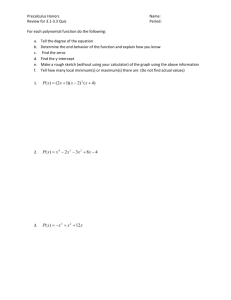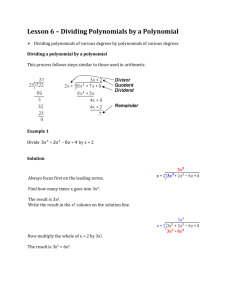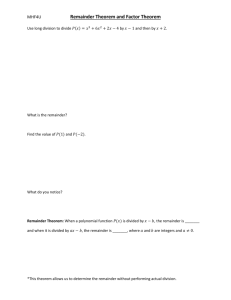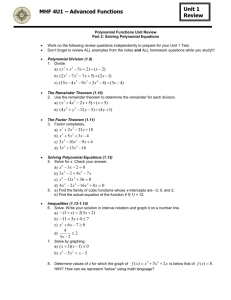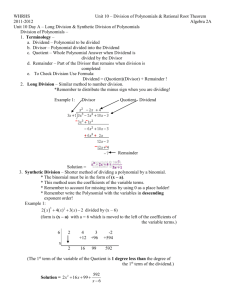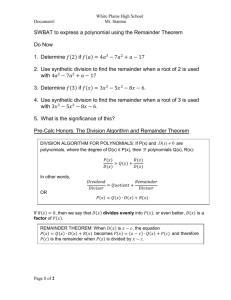171S4.3 Polynomial Division; The Remainder and Factor Theorems March 24, 2011 4.3 Polynomial Division; The Remainder and Factor Theorems
advertisement
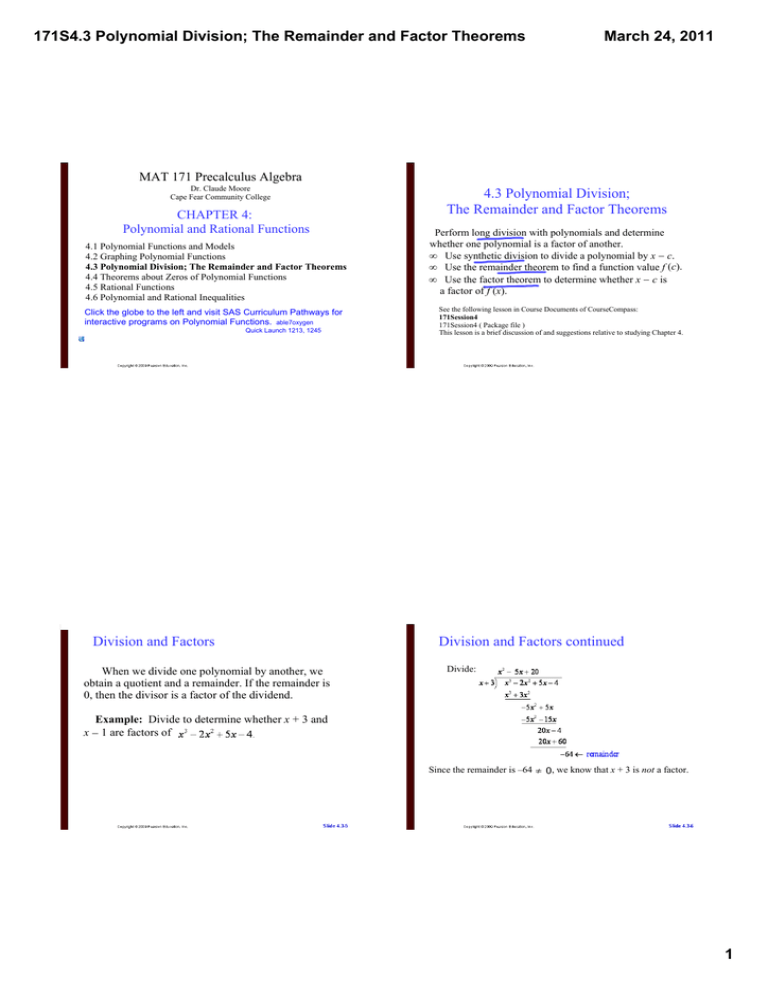
171S4.3 Polynomial Division; The Remainder and Factor Theorems March 24, 2011 MAT 171 Precalculus Algebra Dr. Claude Moore Cape Fear Community College CHAPTER 4: Polynomial and Rational Functions 4.1 Polynomial Functions and Models 4.2 Graphing Polynomial Functions 4.3 Polynomial Division; The Remainder and Factor Theorems 4.4 Theorems about Zeros of Polynomial Functions 4.5 Rational Functions 4.6 Polynomial and Rational Inequalities Click the globe to the left and visit SAS Curriculum Pathways for interactive programs on Polynomial Functions. able7oxygen Quick Launch 1213, 1245 Division and Factors When we divide one polynomial by another, we obtain a quotient and a remainder. If the remainder is 0, then the divisor is a factor of the dividend. 4.3 Polynomial Division; The Remainder and Factor Theorems Perform long division with polynomials and determine whether one polynomial is a factor of another. • Use synthetic division to divide a polynomial by x − c. • Use the remainder theorem to find a function value f (c). • Use the factor theorem to determine whether x − c is a factor of f (x). See the following lesson in Course Documents of CourseCompass: 171Session4 171Session4 ( Package file ) This lesson is a brief discussion of and suggestions relative to studying Chapter 4. Division and Factors continued Divide: Example: Divide to determine whether x + 3 and x − 1 are factors of Since the remainder is –64 ≠ 0, we know that x + 3 is not a factor. 1 171S4.3 Polynomial Division; The Remainder and Factor Theorems Division and Factors continued Divide: Since the remainder is 0, we know that x − 1 is a factor. The Remainder Theorem If a number c is substituted for x in a polynomial f (x), then the result f (c) is the remainder that would be obtained by dividing f (x) by x − c. That is, if f (x) = (x − c) • Q(x) + R, then f (c) = R. Synthetic division is a “collapsed” version of long division; only the coefficients of the terms are written. March 24, 2011 Division of Polynomials When dividing a polynomial P(x) by a divisor d(x), a polynomial Q(x) is the quotient and a polynomial R(x) is the remainder. The quotient must have degree less than that of the dividend, P(x). The remainder must be either 0 or have degree less than that of the divisor. P(x) = d(x) • Q(x) + R(x) Dividend Divisor Quotient Remainder Example Use synthetic division to find the quotient and remainder. Note: We must write a 0 for the missing term. The quotient is – 4x4 – 7x3 – 8x2 – 14x – 28 and the remainder is –6. 2 171S4.3 Polynomial Division; The Remainder and Factor Theorems Example March 24, 2011 The Factor Theorem Determine whether 4 is a zero of f(x), where f (x) = x3 − 6x2 + 11x − 6. We use synthetic division and the remainder theorem to find f (4). For a polynomial f (x), if f (c) = 0, then x − c is a factor of f (x). Example: Let f (x) = x3 − 7x + 6. Factor f (x) and solve the equation f (x) = 0. Solution: We look for linear factors of the form x − c. Let’s try x − 1: f (4) Since f (4) ≠ 0, the number 4 is not a zero of f (x). 329/2. Use long division to determine whether (a) x + 5 is a factor of h(x) = x3 ­ x2 ­ 17x ­ 15. Example continued Since f (1) = 0, we know that x − 1 is one factor and the quotient x2 + x − 6 is another factor. So, f (x) = (x − 1)(x + 3)(x − 2). For f (x) = 0, we have x = − 3, 1, or 2. Each root has a multiplicity of one; thus, the graph crosses the x­axis at each of the x­intercepts (­3,0), (1,0), and (2,0). 3 171S4.3 Polynomial Division; The Remainder and Factor Theorems 329/10. Use long division to find the quotient Q(x) and the remainder R(x). Express P(x) = d(x)Q(x) + R(x). P(x) = x4 + 6x3; d(x) = x ­ 1 329/22. Use synthetic division to find the quotient and remainder. (3x4 ­ 2x2 + 2) ÷ (x ­ 1/4) March 24, 2011 329/14. Use synthetic division to find the quotient and remainder. (x3 ­ 3x + 10) ÷ (x ­ 2) 329/26. Use synthetic division to find the function values. Check with calculator. f(x) = 2x4 + x2 ­ 10x + 1; f(­10) = 4 171S4.3 Polynomial Division; The Remainder and Factor Theorems 329/30. Use synthetic division to find the function value of f(2 + 3i) when f(x) = x5 + 32. Check with calculator. March 24, 2011 330/35. Using synthetic division, determine whether the numbers are zeros of the polynomial function g(x) = x3 ­ 4x2 + 4x ­ 16; i, ­2i 330/50. Sketch the graph of the function. Use synthetic division and the remainder theorem to find zeros. f(x) = x4 + x3 ­ 3x2 ­ 5x ­ 2 330/44. Factor the polynomial function. Then solve f(x) = 0. f(x) = x3 ­ 3x2 ­ 10x + 24 5

